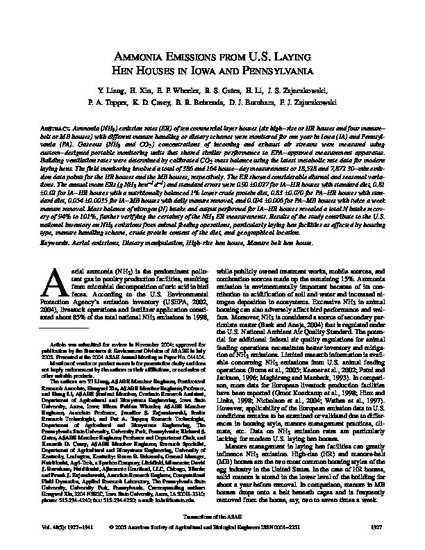
Ammonia (NH3) emission rates (ER) of ten commercial layer houses (six high-rise or HR houses and four manure- belt or MB houses) with different manure handling or dietary schemes were monitored for one year in Iowa (IA) and Pennsylvania (PA). Gaseous (NH3 and CO2) concentrations of incoming and exhaust air streams were measured using custom-designed portable monitoring units that shared similar performance to EPA-approved measurement apparatus. Building ventilation rates were determined by calibrated CO2 mass balance using the latest metabolic rate data for modern laying hens. The field monitoring involved a total of 386 and 164 house-day measurements or 18,528 and 7,872 30-min emission data points for the HR houses and the MB houses, respectively. The ER showed considerable diurnal and seasonal variations. The annual mean ERs (g NH3 hen-1 d-1) and standard errors were 0.90 ±0.027 for IA-HR houses with standard diet, 0.81 ±0.02 for IA-HR houses with a nutritionally balanced 1% lower crude protein diet, 0.83 ±0.070 for PA-HR houses with standard diet, 0.054 ±0.0035 for IA-MB houses with daily manure removal, and 0.094 ±0.006 for PA-MB houses with twice a week manure removal. Mass balance of nitrogen (N) intake and output performed for IA-HR houses revealed a total N intake recovery of 94% to 101%, further verifying the certainty of the NH3 ER measurements. Results of the study contribute to the U.S. national inventory on NH3 emissions from animal feeding operations, particularly laying hen facilities as affected by housing type, manure handling scheme, crude protein content of the diet, and geographical location.
Available at: http://works.bepress.com/richard-gates/29/

This article is from Transactions of the ASAE 48, no. 5 (2005): 1927–1941.